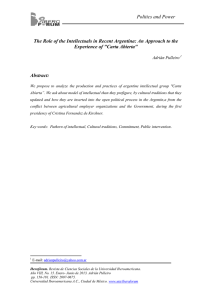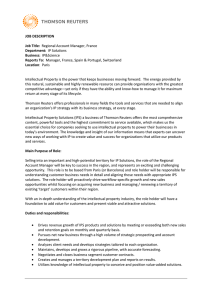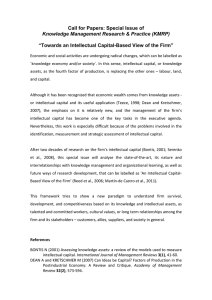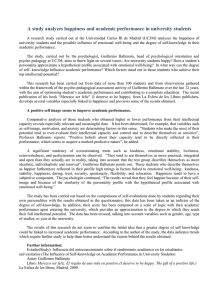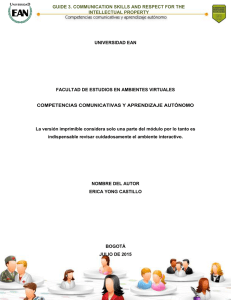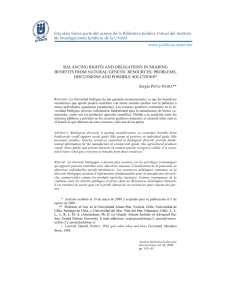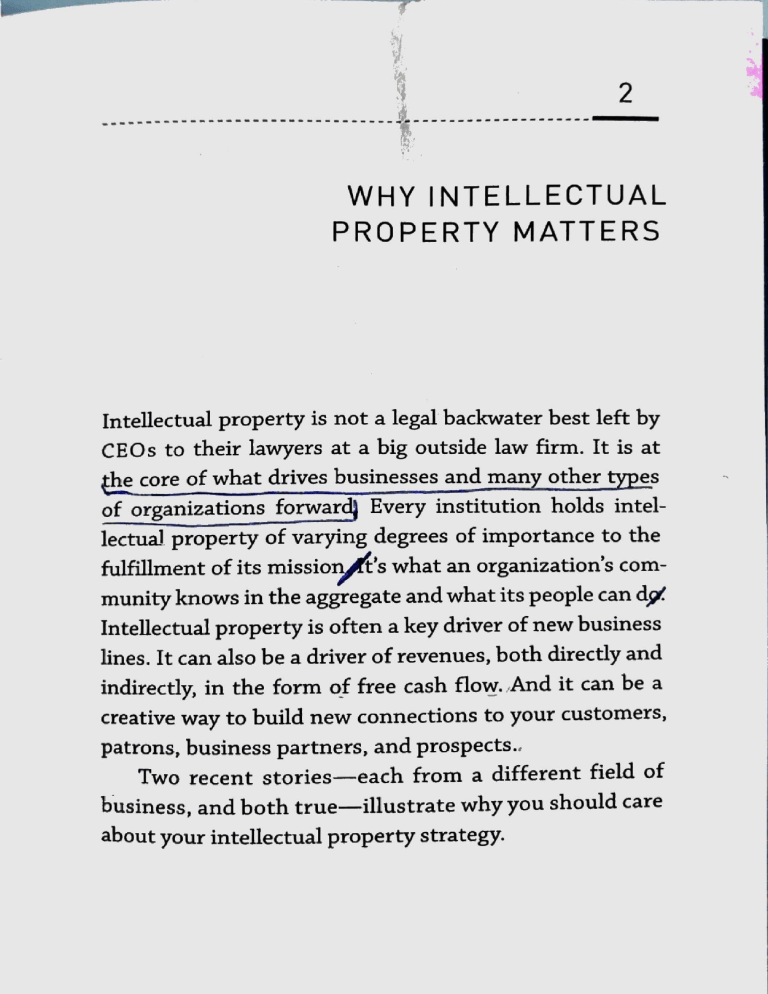
2 WHYINTELLECTUAL PROPERTY MATTERS Intellectual property is not a legal backwater best left by CEOsto their lawyers at a big outside law firm. It is at the core of what drives businesses and many other types of organizations forward) Every institution holds intellectuaJ property of varying degrees of importance to the fulfillment of its mission t'swhat an organization's com- munity knows in the aggregate and what its people can d". Intellectual property is often a key driver of new business lines. It can also be a driver of revenues, both directly and indirectly,in the form of free cash flow.And it can be a creativeway to build new connections to your customers, patrons, business partners, and prospects.. Two recent stories—each from a different field of business, and both true—illustrate why you should care about your intellectual property strategy. The Smartphone Let'ssay you want to develop a new smartphone to pete with Apple's blockbuster iPhone. Youknow,offthe bat, that there are thousands of patents standingbetween you and the launch of your new smartphone. In intellectual property lawyer speak, you may hear someone tell you that there are thousands of patents that "read"on the phone you are proposing to build. Samsung had such a plan in mind a few yearsago.It set about to develop a new, competitive smartphoneto take back some of the market share claimed by the likesof Apple. But as Samsung found, a semiconductor company called InterDigital, based in King of Prussia, Pennsylvania, had a series of patents based on innovations over several decades.After a long-running and distracting patentinfringement fight,in January 2009, Samsung agreed to pay InterDigital $400 million over four years. Nokia was already on the hook for a $253 million payment to Inter- Digital. (Set aside for the moment the hard problem of whether InterDigital'swork constituted real innovation or the operations of a "patent troll,"also known as "non- practicing entities"—a method of merely holding up companies from obtaining licenses—as some allege.) So why wasn't this a problem for Apple, the maker Of the iPhone? 1Or for Research in Motion (RIM), which makes the BlackBerry?Neither of these giants of the smartphone 18 CHAPTER 2 industry ran into this same trouble in court, at least on this score. The reason is that they both had negotiated licenses up front with InterDigitaI.The InterDigital intellectual property was alreadypart of their portfolio—their 'bundle of rights"—when they went to market with their product.2 Perhaps Samsung in the smartphone smartphones system, which willend up passing Apple and RIM business. (They have some promising on the market that run Google's Android is fast gaining a market share as of 2011.) And perhaps the InterDigital licensing matter had little to do with the outcome, in which Apple and RIM have been thriving, and Samsung has struggled to succeed in the US market. No matter what, Samsung lost time, focus, and money as a result of getting tangled with InterDigital. The lesson: like it or not, the intellectual property that other organizations have amassed matters a great deal in terms of enabling you to pursue your emerging business goals. Like it or not, you have to acceptthat the rights of other organizations will set the playing field—and may affect the ultimate outcome of the game. As in the case of Apple and RI M , it will pay off to do your homework first and initiate your business plan grounded in a keen assessment of the risks that lie around you in property ecosystem. You may decide to run the intellectual certainrisksand plow ahead as planned, or you may pause to consider alternate means of proceeding. At a minimum, WHY INTELLECTUAL PROPERTY MATTERS 19 of the intellectual property understanding your strong how much to invest in the decide to help scape will surely prospects, and the range of its assess to how business line, possible outcomes. The Lovable Character (CT W) launched Sesame Workshop Television The Children's it consulted peconcept, the developing In Streetin 1969. of many stripes. educators and psychologists, diatricians, the way, it Along series. television hit a with It came up children dreamed up a series of characters to teach through the educationaltelevision. Through the characters and creativity of the programming, the CTW managed to develop a strong connection with the kids who tuned in to its shows. One of the characters, Elmo, struck a particular chord with children. Elmo is usually up to something interesting—though tame, of course—and carries it out in a sweet, bumblingmanner.It's not clear if Elmo is a boy or girl. Youngchildren just learning to speak and interact with the world—agestwo or three, especially—relate to Elmo in an uncanny way. It is hard to describe the connection that kids feeltoward Elmo. But as many can be extremely 20 CHAPTER 2 strong. parents know, it The CT W was founded to create educational television shows, not to manufacture products. It'salso a nonprofit. But that has not stopped it from making a great deal of money from the relationship that Elmo has with fans. For more than a decade, the CT W has been licensing certain trademark rights and copyrightsthat it holds in Elmo— along with friends Big Bird, Grover, and others—to forprofit organizations. It has set out to create and exploit a licensing market for their characters not just in the United States but also around the world. And they've been exceptionally successful Now in this regard. picture yourself, as a parent, walking down the juice aisle in the supermarket. Your three-year-old is in the child seat of the shopping cart. You reach for the lowest- priced apple juice, and just then, your child notices Elmo on a smaller, pricier bottle. After a brief, intense negotiation,you switch apple juices.You end up buying the more expensive bottle. You pay more for less in the way of apple juice, but avoid a major public battle with your little one. The net effect of this everyday story is that millions of dollars flow to the CTW and higher profits accrue to the manufacturers that take out a license to use Elmo's image on consumer-facing food products. There's another benefit that is important to mention at this stage. It's possible that the CTW would have gone down the road of licensing the use of its characters purely WHY INTELLECTUAL PROPERTY MATTERS 21 for the money. But it'sgotten another benefit from this strategy: much greater reach for its charactersandideas Through these deals, other people pay the CTWfor theright to spread the word about its characters. So long as theCTw makes good choices about its partnerships, the neteffect of licensing is not just money but also greater value in the brand itself (up to a point) and more kids comingbackto watch the programs that feature the characters.A sound licensing strategy drives both parts of the CTW's double bottom line. One might tell a similar story about Dora the Explorer, owned by Viacom, the parent of Nickelodeon and Nick Jr., becausethe tweens and teens segment is particularly hot today. Disney's High SchoolMusical, for instance, is considered an especially desirable brand to license. Or Disney's hit princess characters—based, by the way, not on char- acters that Disney's on-staff "creatives" dreamed up but instead on popular stories long in the public domain, such as Snow White and Beauty and the Beast. Both Viacom and Disney are profiting handsomely from the sales of their hit charactersand entertainment properties. While Viacom doesn't have the same public-interested mission that the CTW does, the effectivelicensing of Dora materials contributes to the likelihood that a child will visit Dora's Web site or look for her shows in the on-demand section of their cable offerings, which drives a virtuous cycle. 22 CHAPTER 2 These stories each make a slightly different point about the importance of intellectual property to your organization. The first is about the significanceof obtaining and using patent rights, with a proactive rather than reactive mind-set. It's clear that one would rather be Apple or InterDigitalthan Samsung or Nokia. The second narra- tive,about trademark and copyright interests,demon- strates how the educators and producers behind Sesame Street have created an extraordinary public service enter- prise, and have additionallyfueled it with character-related, cash-producing marketing as well as free exposure for their brands. In each of these cases, smart intellectual property strategy has led to big returns for the organizations that have leveraged the intangible but highly valuable knowledge-based assets of their organizations. What Is Intellectual Property, Exactly? What can you protect through intellectual property rights? Generally, original ideas, expressive works, and the words and images (and even sounds and colors)that describe brands can be protected through intellectual property systems. For example, a novel method of manufacturing something can be patented through the US Patent and Trademark Office and its counterparts around the world. The process often takes several years to obtain an issued WHY INTELLECTUAL PROPERTY MATTERS 23 patent, but you can frequently produce benefitsfor your organization even through the act of filinga patent appli- cation. (In some cases, business methods can be patented too, though current trends in the law point toward greater and greater difficulty in patenting such processes.)3When you come up with a new logo or brand for your serviceor product, you can register that "mark"—a vice mark—at trademark or ser- the state and federal levels in the United States as well as other jurisdictions around the world where you plan to do business. The same goes for copyrighting a new song, book, movie script, or the like. It is worth pausing for a moment to acknowledge that we're in the midst of a major, multiyear politicaldispute about intellectualproperty. Though not the primary topic of this book, there's a vibrant discussion in the United States and other countries about whether intellectualproperty rights have grown too much over the past two hundred years. For instance, the extension of the copyright term in 1998—the Sonny Bono Copyright Term Extension Act tacked on twenty years to the length of time that a copy- right holder has to enjoy their exclusiverights, now for a period measured by their lifetime plus seventy years— gave rise to a US Supreme Court challenge. The challeng- ers, led by law professor Lawrence Lessig, made a forceful argument against copyright term extension,but came up short by a vote of seven to two. The efforts of the Recording Industry Association of America to enforce the copyright 24 d CHAPTER 2 interests of its members, the music recording labels, has prompted a backlash among customers and a movement called "Free Culture" on college campuses. The debates over patent reform are just as robust. The largest of the ques- tions are: How and when do intellectual property rights innovation, inhibit or stimulate can we optimize and how the system from a public policy vantage point? These are important politicaldiscussions,and it wouldbe smart to be aware of and perhaps participatein them as they develop further. (A few of the books, blogs, and other Web sites in the reading list at the end of this book cover these debates along with the related intellectual property issues. I say a bit more on this front in chapter 9.) 4 For my purposes here, let's take the intellectual property regime as it is.5 My premise is to consider together what you might do, as a company, within the legal and business framework of intellectual property as it exists today. In the best intellectual property strategies, you will anticipate and benefit from future trends as well. The process of acquiring intellectual property begins can with an analysis of how best to go about i . Beforeyou only do enter a new market or aunch a new product, not business you need to have a thorough knowledge of your human and ecosystem; you also have to come up with the it successful. You financial capital to make convince someone-—your an angel investor—to put hire a team and board, a bank, a customer, or know is up the capital that you WHY INTELLECTUAL PROPERTY MATTERS 25 the fund to needed Now is also the right work. necessary development or the product of beginning the at your intellectualproperty time, about think to pansion cycle, business strategy. of a team develop sometimes or members individual organization. some An single a within property is in the intellectual intellectual property made to be money of the in within and know-how information this to exploit example. ability of the Samsung Think organization. your own smartphone-related patents, hold may Your organization which create the freeinnovation, own based on your have smartphone that you the develop dom of actionto a bargaining serve as also might patents in mind.These where with a competitor, chip for a cross-license you agree for a license exchange in them to rights to licenseyour Or it might be rights. your with associated you backto Apple front for a license, as that you simply have to pay up The and RIM presumably did, to build your smartphone. a new market same might be true ifyou intend to enter rights in with an existingproduct, where a competitor has a given country that you seek to enter, since intellectual property rights tend not to be global in nature, unless you invest heavily from the start in obtaining tections.You would also need to consider, in turn, whether worldwide pro- to protectyour new innovations as you develop the phone, through both patent and trade secret protection, to stop others in remote jurisdictions from copying your product 26 CHAPTER 2 and flooding the international market with lower-cost imitation goods. A similar analysis would help you to determine whether you could use a given name to describe your new service. You'll need to choose the brand name carefully, for two reasons. First, you'll be investing a lot in marketing that brand, so you want it to be defensibleagainst others using it in the future. Just as important, someone coming you want to avoid after you for infringing on their right to use a given name in commerceto describe a service—or be prepared to switch to marketing using a new name. You might want to check how your proposed brand name translates into other languages,like the classicexample Nova in the Spanish language, which of the Chevy meant "no go." In the digital age, this analysis would extend also to the domain name space, where a search will help determine what domain names you will be able to claim for your product or service. Many organizations will register domain names similar to their own name in order to prevent others from doing so once there's value in the brand—a practice known as "cybersquatting" or "typo-squatting." This analysis will take you down the road of considering whether to apply for a trademark or service mark, and at what level. It can get expensiveto file, maintain, and monitor intellectual property protections in multiple jurisdictions over time—but it can also lead to enormous opportunities in future licensing or other business revenue. WHY INTELLECTUAL PROPERTY MATTERS 27 For instance, in a future joint venture nario, the fact that you have perfected or acquisition your rights in a lead. ing brand might lead to a premium paid by the other side in the deal. consider, instead, whether You might name else in order to help you sell more someone from to license a brand units or service plans. Perhaps the phone smartphone is not a full-function you have in mind but rather a plastic non- working phone marketed to small children. Youwillneed to stamp a picture of the most popular characterfor the moment, whether toy to convince it is Dora the Explorer kids to pester or Elmo, on the their parents into buying it. In either of these cases, you'd need a license from the owner of the relevant intellectual property rights to market your plastic phone. This same intellectual property analysis plays out in a wide range of industries before a product or service can be released for sale or otherwise offered to the public. In the movie business, lawyers and their teams obtain copyright clearance from many different people film; in turn, the movie itself may to put out a feature enable the creators to count on revenuesfor years to come from licensing as- pects of the film. Think of Star Wars, for example, and the long tailof revenue that has been generated for the own- ers of that intellectual property well after the movies have stopped running in the theaters. The same is true for some musical productions and sound recordings, books, and vir 28 CHAPTER 2 tually every complex creative endeavor. It's also the case for nonprofit producers of documentary films, like Boston's WGBH, the producer of the award-winning Frontline program,among many others. In each of these instances, the first premise is that you need to acquire the rights to certain intellectual property in order to reap benefits from them later on. In establishing your rights clearly, you create the freedom of action for your organization to enter into new markets with new products. A wide and deep intellectual property portfolio on your balance sheet means you'll have broader freedom of action without new outlays of capital. Whether or not you have to go into the marketplace to buttress the rights that you have, you will need a fairly sophisticatedcostbenefit analysis to determine whether and how much to invest on the front end in intellectual property protection or licenses from others. The intellectual property licensing business is big business, with good reason. There's even another layer of the business: insurance and financing issues related to the acquisition and management of in- tellectual property rights as it becomes clearer that they represent an important asset class. Just as it is about creating freedom of action to oper- ate and generating revenues, your intellectual property strategy is also about risk reduction. If you are launching a serious new start-up, you wouldn't think of using a do-ityourself kit from the Internet to form a new corporation WHY INTELLECTUAL PROPERTY MATTERS if 29 you have big plans. The money a new corporation investment spent on lawyers to create and divide up the equity is a against problems pany grows, spending money down worthwhile the road. As your corn- on lawyers to structure uity agreements for new employees and plan for defenses in takeover scenarios is likewise a good investment. The same logic applies when it comes to building an intellectual property portfolio, which can emerge as a key aspect of your overall equity in the business. Each of these investments in lawyers—setting up a company, planning and continuous operations, and establishing for smooth an intellectual property insurance policy for your organization Investments as a crucial portfolio—functions as itgrows. in your intellectual property portfolio re- duce risk by establishing greater clarity around whatyou can do as an organization without violating the rights of oth- ers, even in an unintentional way. By amassing intellectual property rights, and registering or publishing information about these assets—whether in ideas, forms of expression, or brands—you establish and retain for your organization the abilityto do more or less whatever you like with those rights later.That might mean exploiting them on your own, licensing some or all of those rights to others, or giving the rights freelyaway to others. Put another way, these investments ensure, firstand foremost, that your organization has freedom of action later. As just one example, the documents 30 that you painstakingly get every new CHAPTER 2 employee to By amassing intellectual property rights, and registering or publishing information about these assets—whether in ideas, forms of expression, or brands—you establish and retain for your organization the ability to do more or less whatever you like with those rights later. sign—inventor's rights agreements, say—ensure work you are paying for redounds to the benefitof the organization, not the start-up that your employee Your I to join. These investments in work related eaves to reduce risks that are almost property certain to tual under the protection of the on what others can do with them. Even in a ting like a university, it can be important your employees nonprofit to have signed over some ensure that or all of the rights in what they produce to you, unless for some reason you want them to retain those rights. Up-front investments in intellectual property reducethe risk and cost of litigation. In alsocan the intellectual property field, litigation is incredibly expensive.Virtually everyone (other than the intellectual property litigators and certain organizations whose business purpose itisto sue others) wishes to avoid intellectual The costs of lawsuits are enormously propertylitigation. high—let alonethe possiblecosts of negative publicity and the distraction caused by extended litigation. A bill for $3 to $5 millionin legal fees per side in a medium-sized matter is common. 6 The possibility of damages—which can reach into the hun- dreds of millions or even billions of dollars—caneasilyjustify the expenses on the plaintiff's side, and canlikewise asetprovide a strong incentive to defendants to negotiate tlement to avoid a costly courtroom battle. It's notmuch 32 CHAPTER 2 of a reach to speculate, for example, that Google's large settlement with Yahoo! early in Google's rise to promi- nence—-inwhich Google transferred about $328 million in stock to Yahoo!—was a function of Google's recognition that the damages could be immense—and Google's own growth stunted—if It should come Yahoo! were to have prevailed.7 as no surprise that having certainty in intellectual property rights can lead to earlier and cheaper settlements. Control ofintellectual property rights of your own can sometimes even preclude such action in the first place. In cases where both parties know the strength of the other party's rights, the total cost of the transaction— in lawyer's fees and other direct expenses—willlikely be competitors) lower. The investment that you (and your make in clearly establishing your intellectual property rights may keep down your lawyer's fees and other costs associatedwith uncertainty down the road. Establishingan Intellectual Property Strategy As a CEO or senior manager of any sort of organization, you should establish a dynamic intellectual property strategy.The strategy needs to be explicit, such that day-to-day decisionscan be evaluated against it and so that the decisions drive toward helping you make the right institutional goals. Too much decision making related to intellectual WHY INTELLECTUAL PROPERTY MATTERS 33 property is made randomly or in a way that is isolated from the whole. This strategy needs to be dynami you are adjusting it over time to take full advantage of the field's fast-changing circumstances, opportunities, risks. The strategy needs to be nuanced. It has to be tailored to specific es of assets and nota In establishing and implementing su a strategy,con. sider four core recommendations. First, treat intellectual property as a flexible asset class and manage it accord. ingly—even when precise valuation is uncertain. Second, be open to ways of using outside intellectual propertythat was not developed within your organization (in waysthat are perfectly legal, of course). Third, consider the primary use of intellectual property as ensuring your own freedom of action to compete effectively, rather than an offensive weapon. And last, establish a mechanism withinyouror- ganization that guarantees that you remainflexible and develop the capacity for creative foresight with respectto intellectual property strategy over time. By amassing intellectual property rights, and register ing or publishing information about these assets—whether in ideas, forms of expression, or brands—youestablish and retain for your organization or the ability to do more less whatever you like with those rights later. 34 CHAPTER 2
